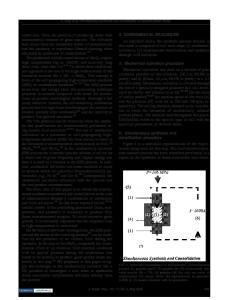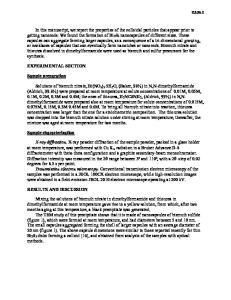Simultaneous Fast Dehydrogenation of TiH 2 and Rapid Synthesis of TiB 2 -TiC Through Self-Propagating High-Temperature S
- PDF / 419,289 Bytes
- 5 Pages / 593.972 x 792 pts Page_size
- 64 Downloads / 299 Views
mic matrix composites containing TiC and TiB2 are attractive structural materials due to a unique combination of high melting temperature, low densities, good thermal and chemical stability, excellent wear resistance, and high fracture toughness.[1–3] These materials have been fabricated from Ti-B-C or Ti-B4C powder blends by various processing technologies including reactive hot pressing, self-propagating hightemperature synthesis (SHS), spark plasma sintering (SPS), and transient plastic phase processing.[1–6] For these technologies, expensive hydride-dehydride (HDH) titanium (Ti) powder was always employed as starting material. Titanium hydride (TiH2) is another type of Ti powder source in the current market. It is the intermediate product during the fabrication process of HDH Ti powder.[7] Therefore, it is lower in cost than Ti powder. The current market price of TiH2 powder is about half of HDH Ti powder with an equivalent particle size and similar impurity content. However, two major barriers existed for the use of TiH2: long annealing time required Y.F. YANG, ARC DECRA Fellow, is with the School of Aerospace, Mechanical and Manufacturing Engineering, RMIT University, Melbourne, VIC 3001, Australia, and also with the School of Mechanical and Mining Engineering, The University of Queensland, Brisbane, QLD 4072, Australia. Contact e-mail: yangyafeng8@ gmail.com, [email protected] D.K. MU, Postdoctoral Research Fellow, is with the School of Mechanical and Mining Engineering, The University of Queensland. Manuscript submitted August 14, 2013. Article published online April 19, 2014 3184—VOLUME 45A, JULY 2014
to preliminarily remove the H before using and the difficulty to completely remove H. It would be of great benefit if we could incorporate this dehydrogenation process into a single run of TiC-TiB2 synthesis from TiH2-B4C. Sintering and/or mechanical alloying have been attempted to fabricate TiC-TiB/Ti matrix composite from TiH2-B4C.[5,6] However, both technologies were very time consuming and/or incurred impurities. In contrast, technically simple and economically attractive SHS technology appears to be a promising technology, by which partial H can be removed during heating prior to reaction and the dehydrogenation continues in the following self-sustained reaction. However, the authors have not found any reports in literature on this phenomenon. The objectives of the present work are to explore the possibility of synthesizing TiC-TiB2 by the SHS reaction from TiH2-B4C powder mixture, and to understand the mechanism of the TiC-TiB2 formation during the SHS process. In addition, the mechanical properties of dense bulk TiC-TiB2 material made from TiH2-B4C were assessed. For the sake of comparison, the SHS reaction from Ti-B4C was also performed to fundamentally understand the SHS reaction mechanism from TiH2-B4C. Commercial powders of TiH2 (£38 lm, 99.5 pct, 0.4 pct O), Ti (£38 lm, 99.5 pct, 0.4 pct O), and B4C (£25 lm, 99.9 pct) were used. The molar ratios of Ti or TiH2 to B4C were 3:1 to obtain TiB2-TiC o
Data Loading...











